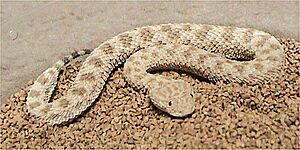Cerastes vipera facts for kids
Quick facts for kids Cerastes viperaTemporal range: Pleistocene-recent
|
|
|---|---|
 |
|
| Conservation status | |
| Scientific classification | |
| Genus: |
Cerastes
|
| Species: |
vipera
|
 |
|
| Synonyms | |
|
|
The Sahara sand viper (Cerastes vipera), also known as the Avicenna viper, is a type of viper snake. It lives only in the deserts of North Africa and the Sinai Peninsula. This snake is venomous, like all other vipers. There are no different types (subspecies) of this snake known.
Contents
About the Sahara Sand Viper
What Does It Look Like?
Adult Sahara sand vipers are usually 20 to 35 centimeters (8 to 14 inches) long. The longest one ever found was about 50 centimeters (1.6 feet) long. Female snakes are typically larger than males.
This snake is small and strong. It has a wide, triangular head. Its small eyes are placed forward on its head, right where the side and top meet.
How Does It Hunt?
The Sahara sand viper has a special way of hunting. It uses two main methods. Sometimes, it will sit and wait for its prey to come by. Other times, it will actively hunt for food.
It often hunts actively in the months before it goes into hibernation. This helps the snake eat enough to store energy for its long rest period.
Other Names for This Snake
People call the Sahara sand viper by a few different names. These include:
- Sahara sand viper
- Avicenna viper
- Common sand viper
- Egyptian asp
- Cleopatra's asp
- Sand viper
- Avicenna's sand viper
- Lesser cerastes
Where Does It Live?
This snake lives in the dry areas of North Africa. You can find it in countries like:
It also lives in the Sinai Peninsula, which includes parts of:
The first place this snake was officially recorded was in "Ægypto," which means Egypt.



